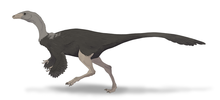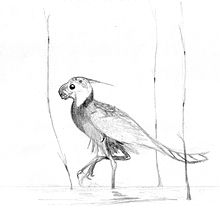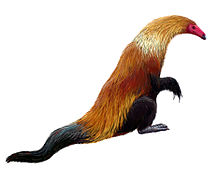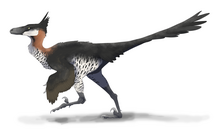This is an old revision of this page, as edited by Tisquesusa (talk | contribs) at 12:45, 4 November 2019 (Undid revision 924476516 by BrownHairedGirl (talk)). The present address (URL) is a permanent link to this revision, which may differ significantly from the current revision.
Revision as of 12:45, 4 November 2019 by Tisquesusa (talk | contribs) (Undid revision 924476516 by BrownHairedGirl (talk))(diff) ← Previous revision | Latest revision (diff) | Newer revision → (diff)| Iren Dabasu Formation | |
|---|---|
| Stratigraphic range: Santonian ~86–83 Ma PreꞒ Ꞓ O S D C P T J K Pg N ↓ | |
| Type | Geological formation |
| Unit of | Paysandú Group |
| Overlies | Arshanto Formation |
| Area | Erenhot near Erlian city |
| Thickness | 30 m (98 ft) |
| Lithology | |
| Primary | Sandstone, claystone, siltstone |
| Other | Glutenite |
| Location | |
| Coordinates | 43°48′N 112°24′E / 43.8°N 112.4°E / 43.8; 112.4 |
| Approximate paleocoordinates | 43°06′N 101°00′E / 43.1°N 101.0°E / 43.1; 101.0 |
| Region | Inner Mongolia |
| Country | |
| Type section | |
| Named for | Iren Dabasu |
| Named by | Osborn |
| Year defined | 1922 |
  | |
The Iren Dabasu Formation is a Late Cretaceous (Santonian) geologic formation in the Iren Nor region of Inner Mongolia. Dinosaur remains diagnostic to the genus level are among the fossils that have been recovered from the formation. It is located in the Iren Nor region of China.
Description
The ostracod and charophyte assemblages of the Iren Dabasu Formation has suggested a potential correlation with those of the Sifangtai Formation and the basal Mingshui Formation in the Songliao Basin (mid/late Campanian age). Vertebrates point to an older date than middle-late Campanian. The turtle Khunnuchelys is known from both Iren Dabasu and Baynshirenian-equivalent units such as the Bostobe and Bissekty. In addition, a giant Caenagnathid similar to Gigantoraptor is now known from the Baynshirenian beds of Tsagaan Teg. Like the coeval Baynshiree (or possibly Javkhlant) Formation in the Gobi, the dinosaur fauna of the Iren Dabasu Formation includes tyrannosaurs, ornithomimids, therizinosaurs and oviraptors.
Lithology
It is comprises continental clastic sediments consisting of light grey fine sandstones, coarse sandstones and glutenites as well as mottled claystones and siltstones. The fine-grained floodplain sediments and the coarse-grained sediments of the point bar formed a series of repeated frequently binary sedimentary rhythms. The “binary structure” of the sedimentary rhythms strongly indicates meandering stream deposits rather than braided river deposits as previously thought
Fossil content
Dinosaur eggs described as Spheroolithus irenensis were named after the formation.
Dinosaurs
Ornithischians
| Genus | Species | Location | Stratigraphic position | Material | Notes | Images |
|---|---|---|---|---|---|---|
|
B. johnsoni |
"Disarticulated, associated skull and postcranial material pertaining to at least individuals, juvenile to adult." |
A hadrosauroid that was it one of the earliest known hadrosauroids, and although it is not known from a full skeleton, it is one of the best known of these forms of hadrosaur predecessors. It would have been 6 meters (20 ft.) long and 2 meters (6.6 ft.) high when standing on all fours, and weighed 1.1 to 1.5 tonnes (2,400 to 3,300 lb.), with an 80 centimeters (2.6 ft.) femur. | ||||
|
G. mongoliensis |
"Isolated skull material, associated, disarticulated postcrania, at least individuals." |
A hadrosauroid known from very fragmentary remains. |
Saurischians
| Genus | Species | Location | Stratigraphic position | Material | Notes | Images |
|---|---|---|---|---|---|---|
|
A. olseni |
A tyrannosaur that could grow up to an estimated 5 meters (16.4 feet) long, with long tibias. Also found in the Bayan Shireh Formation. |
         | ||||
|
A. asiaticus |
"Partial manus, metatarsus, vertebrae, limb elements." |
An ornithomimid about 3.3 meters (11 feet) long, and weighed up to 50 kilograms (110 pounds). The hind limbs were robustly built. | ||||
|
A. portentosus |
A caenagnathoid oviraptorosaur with a length of 1.5 meters (5 feet), at first believed to be an avialan. Also found in the Nemegt Formation. | |||||
|
C. sp |
A caenagnathoid oviraptorosaur unearthed in 2015. | |||||
|
E. bellamanus |
"Partial skeleton." |
A therizinosauroid therizinosaur estimated at 4 meters, the weight at 400 kilograms. For a therizinosauroid, its neck was rather short. | ||||
|
Indeterminate |
||||||
|
G. erlianensis |
A very large caenagnathid estimated at 8 meters (26 feet) and the weight at 2 tonnes (2.2 tons). | |||||
|
M. olecranus |
A mononykin parvicursorine alvarezsaurid only 1 meter (3.3 ft.) long, differing from close relatives in several details of its skeleton, including a pubic bone that is triangular in cross section, and different proportions in the toe bones. Also found in the Nemegt Formation. | |||||
|
N. yangi |
" specimens with most of the axial column, many limb and girdle elements, dentary." |
A therizinosauroid therizinosaur thought to have been about 2.3 meters in length. | ||||
|
Indeterminate |
||||||
|
S. saihangaobeinsis |
A titanosaur sauropod about 9–10 meters (27–30 feet) long. | |||||
|
Indeterminate |
See also
References
- Weishampel, et al. (2004). "Dinosaur distribution." Pp. 517-607.
- Xing, Hai; He Yiming; Li Liguo; Xi Dangpeng (2012). "A review on the study of the stratigraphy, sedimentology, and paleontology of the Iren Dabasu Formation, Inner Mongolia.". In Dong Wei (ed.). Proceedings of the Thirteenth Annual Meeting of the Chinese Society of Vertebrate Paleontology. Beijing: China Ocean Press. pp. 01–44.
- AMNH Loc. 9336, Erenhot at Fossilworks.org
- ^ Weishampel, et al. (2004). "Dinosaur distribution," p. 598.
- ^ "Table 20.1," in Weishampel, et al. (2004). Page 439.
- "Table 6.1," in Weishampel, et al. (2004). Page 138.
- ^ Yao, Xi; Wang, Xiao-Li; Sullivan, Corwin; Wang, Shuo; Stidham, Thomas; Xu, Xing (2015). "Caenagnathasia sp. (Theropoda: Oviraptorosauria) from the Iren Dabasu Formation (Upper Cretaceous: Campanian) of Erenhot, Nei Mongol, China". Vertebrata PalAsiatica. 53: 291–298.
- ^ "Table 7.1," in Weishampel, et al. (2004). Page 152.
- ^ Listed as "?Garudimimus sp." in Weishampel, et al. (2004). "Dinosaur distribution," p. 598.
- ^ Xu, X., Tan, Q., Wang, J., Zhao, X., and Tan, L. (2007). "A gigantic bird-like dinosaur from the Late Cretaceous of China." Nature, 447(7146): 844-847.
Bibliography
Further reading
- X. Yao, X.-L. Wang, C. Sullivan, S. Wang, T. A. Stidham and X. Xu. 2015. Caenagnathasia sp. (Theropoda: Oviraptorosauria) from the Iren Dabasu Formation (Upper Cretaceous: Campanian) of Erenhot, Nei Mongol, China. Vertebrata PalAsiatica 53(4):291-298
- J. Van Itterbeeck, P. Missiaen, A. Folie, V. S. Markevich, D. Van Damme, D.-Y. Guo, and T. Smith. 2007. Woodland in a fluvio-lacustrine environment on the dry Mongolian Plateau during the late Paleocene: Evidence from the mammal bearing Subeng section (Inner Mongolia, P.R. China). Palaeogeography, Palaeoclimatology, Palaeoecology 243(1-2):55-78
- X. Xu, X. Zhang, Q. Tan, X. Zhao, and L. Tan. 2006. A new titanosaurian sauropod from Late Cretaceous of Nei Mongol, China. Acta Geologica Sinica 80(1):20-26
- P. Godefroit, Z.-M. Dong, P. Bultynck, H. Li, and L. Feng. 1998. New Bactrosaurus (Dinosauria: Hadrosauroidea) material from Iren Dabasu (Inner Mongolia, P. R. China). Bulletin de l'Institut Royal des Sciences Naturelles de Belgique, Sciences de la Terre 68(supplement):3-70
- P. J. Currie and D. A. Eberth. 1993. Palaeontology, sedimentology and palaeoecology of the Iren Dabasu Formation (Upper Cretaceous), Inner Mongolia, People's Republic of China. Cretaceous Research 14:127-144
- M. Chow and A. K. Rozhdestvensky. 1960. Exploration in Inner Mongolia: a preliminary account of the 1959 field work of the Sino-Soviet Paleontological Expedition (SSPE). Vertebrata PalAsiatica 4(1):1-1
- C. W. Gilmore. 1933. On the dinosaurian fauna of the Iren Dabasu Formation. Bulletin of the American Museum of Natural History 68(2-3):23-78
- R. C. Andrews. 1932. The New Conquest of Central Asia: A Narrative of the Explorations of the Central Asiatic Expeditions ni Mongolia and China, 1921-1930. Natural History of Central Asia 1:1-678
- H. F. Osborn. 1922. Discovery of Cretaceous and older Tertiary strata in Mongolia. Science 56(1446):291-293